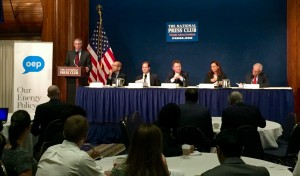 On September 16th, 2015, OurEnergyPolicy.org (OEP) hosted a panel event moderated by Mark Drajem of Bloomberg News on the EPA’s ozone rule and the energy sector at the National Press Club in Washington, DC. EPA is expected to announce a new standard for ground-level ozone, a smog-forming pollutant. Most believe they will reduce the existing standard from 75 parts per billion (ppb) to 65 or 70 ppb by 2025. According to EPA, this would prevent 4,200 premature deaths, between 1,400 and 4,300 asthma-related emergency room visits, and between 320,000 and 960,000 annual asthma attacks in children.
On September 16th, 2015, OurEnergyPolicy.org (OEP) hosted a panel event moderated by Mark Drajem of Bloomberg News on the EPA’s ozone rule and the energy sector at the National Press Club in Washington, DC. EPA is expected to announce a new standard for ground-level ozone, a smog-forming pollutant. Most believe they will reduce the existing standard from 75 parts per billion (ppb) to 65 or 70 ppb by 2025. According to EPA, this would prevent 4,200 premature deaths, between 1,400 and 4,300 asthma-related emergency room visits, and between 320,000 and 960,000 annual asthma attacks in children.
The very spirited discussion largely hit at the cost of compliance. Under the Clean Air Act, EPA is obligated to ensure the ozone standard adequately protects public health and welfare and while EPA estimates that moving to 65 ppb could cost around $15 billion per year, the National Association of Manufacturers (NAM) believes the cost of 65 ppb to be closer to $140 billion per year.
Ross Eisenberg of NAM discussed the progress that has been made in improving air quality. Eisenberg said in 1990 during the signing of the Clean Air Act Amendments “the president estimated the legislation would reduce NOx emissions by 2 million tons. He was wrong… emissions were actually reduced from 24 million tons in 1990 to 12 million tons today.” Eisenberg urged the EPA to consider that lowering the ozone standard to 65 ppb “will be the most expensive regulation ever.”
John Walke of the Natural Resources Defense Council (NRDC) disagreed, maintaining that the Clean Air Act “squarely prohibits economic costs and compliance costs from influencing safer standards.” Walke urged EPA to adopt an aggressive standard, even lower than the commonly suggested 70 ppb, referring to 70 ppb as the “worst standard EPA has actually proposed.”
The EPA’s Ozone rule will likely be established in October; however, discussion over its impact on the energy sector will continue. Below is a video of the discussion and questions posed to the panelists. You can also find a transcript here.
- Ross Eisenberg, National Association of Manufacturers
- John Walke, Natural Resources Defense Council
- Sarah Magruder Lyle, American Fuel & Petrochemical Manufacturers
- Alan Krupnick, Resources for the Future
- Mark Drajem, Editor, Bloomberg’s First Word Energy (Moderator)
A great discussion … Reading through the transcript it became very clear to me that getting to really strong reductions is a complicated matrix of possibilities that actually should make… Read more »
Of interest is the bill introduced yesterday by Senators Hatch and McCaskill, which allows local communities to engage in voluntary cooperative agreements with EPA to develop tailored solutions that can… Read more »